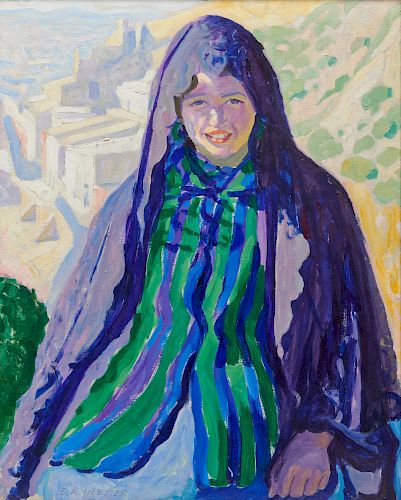E. AMBROSE WEBSTER, (American, 1865-1935), Consuela
Lot 42
Estimate:
$4,000 - $6,000
Absentee vs Live bid
Two ways to bid:
- Leave a max absentee bid and the platform will bid on your behalf up to your maximum bid during the live auction.
- Bid live during the auction and your bids will be submitted real-time to the auctioneer.
Bid Increments
| Price | Bid Increment |
|---|---|
| $0 | $100 |
| $1,000 | $100 |
| $2,000 | $250 |
| $5,000 | $500 |
| $10,000 | $1,000 |
| $20,000 | $2,500 |
| $50,000 | $5,000 |
| $100,000 | $10,000 |
| $200,000 | $25,000 |
| $500,000 | $50,000 |
About Auction
By Grogan & Company
Nov 17, 2019
Set Reminder
2019-11-17 11:00:00
2019-11-17 11:00:00
America/New_York
Bidsquare
Bidsquare : The Fall Auction
https://www.bidsquare.com/auctions/grogan/the-fall-auction-4561
Grogan & Company info@groganco.com
Grogan & Company info@groganco.com
- Lot Description
E. AMBROSE WEBSTER
(American, 1865-1935)
Consuela
oil on canvas
signed E. A. Webster, l.l.
30 x 24 in., frame: 40 x 34 in.
Provenance: The Collection of Dr. Edward Sleeper, Boston, Massachusetts; then by descent.
Literature: Scott, Gail R., E. Ambrose Webster: Chasing the Sun - a Modern Painter of Light and Color, Manchester, VT, 2009, p. 152 (illus).
Other Notes: - Babcock Galleries, New York label verso
- Carnegie Institute, Pittsburgh label verso
E. Ambrose Webster is considered one of the preeminent American Fauvists, best known for the striking colorwork found in his mature style. After beginning his artistic studies at the School of The Museum of Fine Arts in Boston, Webster traveled to Europe in 1896, a turning point in his career. Deeply influenced by the bright colorwork of Monet, van Gogh, and Matisse that he saw during his travels, Webster shifted away from the traditional academic style in which he had been trained, instead drawing to a saturated rendering of light and color. He returned to America and settled in Provincetown, Massachusetts in 1900, opening the Webster Art School. Thirteen years later, he exhibited two works at the seminal 1913 Armory show. Throughout his career, he was celebrated by peers such as Edward Hopper, Maurice Prendergast, and Richard Diebenkorn. The present work, painted in 1918, is an early example of Webster's shift away from landscapes toward the human form. Webster began to paint local women he encountered in his travels, seating them outdoors in bright light as he studied the interplay of light and shadow on their bodies. In these portraits, the women's forms take up much of the composition, the soft-hued background landscape becoming secondary to the vividly painted figure in the foreground. Consuela is a strong example of these portraits, and the thick, confident brushstrokes, the boldly rendered purples of her cloak, and the striking rendering of light across her face are all hallmarks of this transformative period of Webster's career. - Shipping Info
-
Grogan & Company does not offer in-house packing and shipping services; however, we work closely with a number of local businesses who are ready to address any and all of your shipping needs.
Recommended shippers:
Global Pack Ship
617.743.6245
globalpackship@aol.comUPS Store Needham
508.314.1568
store2897@theupsstore.com
-
- Buyer's Premium



 EUR
EUR CAD
CAD AUD
AUD GBP
GBP MXN
MXN HKD
HKD CNY
CNY MYR
MYR SEK
SEK SGD
SGD CHF
CHF THB
THB
















